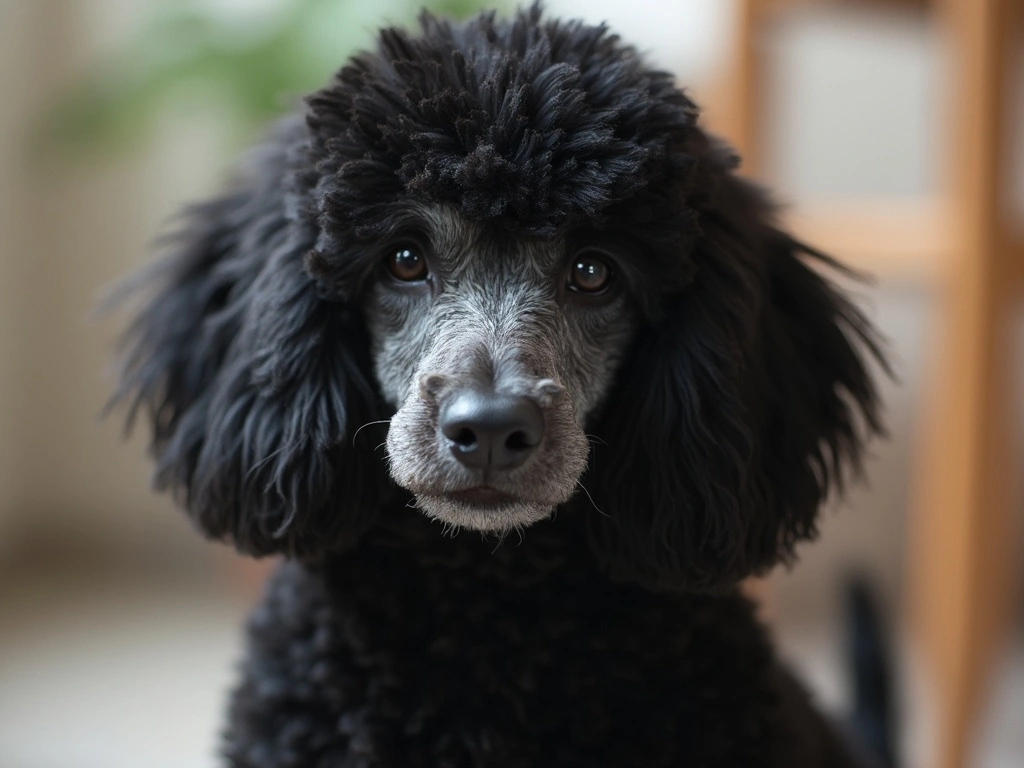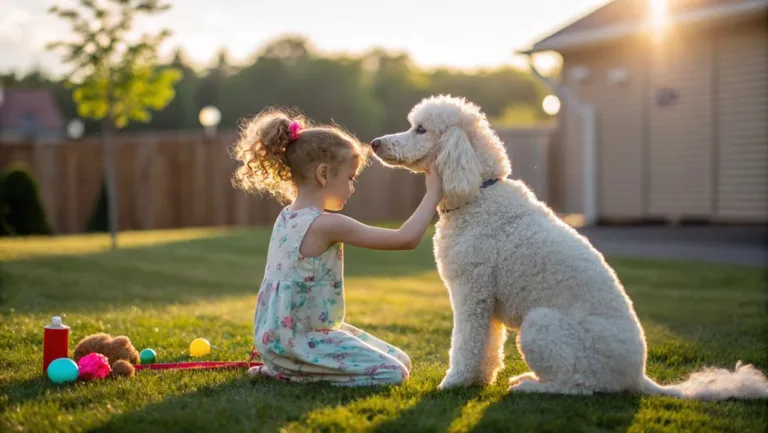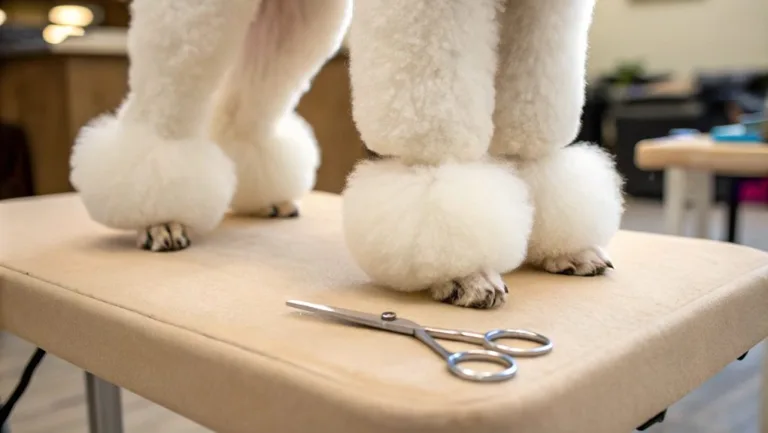Understanding Poodle Hair: Do Poodles Have Hair or Fur?

Poodles have hair, not fur, which is why they’re often considered hypoallergenic. Their hair grows continuously like human hair, requiring regular grooming to prevent matting.
Unlike fur, poodle hair is typically curly or wavy and sheds minimally. It’s a single, dense coat that grows from individual follicles, allowing for versatile styling options.
You’ll need to brush your poodle’s hair daily and schedule regular trims to maintain its health and appearance.
This unique coat originated from the breed’s history as water retrievers, providing insulation and protection. Understanding the distinct properties of poodle hair will help you better care for your furry friend.
Poodle Coat Basics: Hair and Fur
What makes a Poodle’s coat so unique? Unlike most dog breeds, Poodles don’t have fur – they’ve hair.
This distinction is pivotal in understanding their grooming needs and hypoallergenic properties.
Poodle hair grows continuously, similar to human hair, and doesn’t shed seasonally like fur. Their coat consists of a single layer of dense, curly hair that can grow quite long if not regularly trimmed.
This unique characteristic is why Poodles require consistent grooming to maintain their appearance and prevent matting.
The Poodle breed’s hair is often described as hypoallergenic because it sheds minimally, reducing the spread of dander – a common allergen. However, no dog is truly 100% hypoallergenic, and individual reactions may vary.
Proper hair care for Poodles involves regular brushing, combing, and professional grooming every 4-8 weeks.
Their hair can be styled in various cuts, from practical short clips to elaborate show styles. Without proper maintenance, Poodle hair can become matted and tangled, leading to skin issues and discomfort.
By understanding the unique nature of Poodle hair, you can better care for your furry friend’s coat and overall health.
Key Differences between Hair and Fur

While many people use the terms “hair” and “fur” interchangeably when referring to dogs, there are actually significant differences between the two.
When it comes to poodles, you’ll find that they’ve hair rather than fur. Poodle hair grows continuously, much like human hair, and doesn’t shed seasonally like fur does.
This continuous growth means that poodles require regular grooming to maintain their coats.
The key differences between hair and fur include:
- Growth cycle: Hair has a longer growth cycle and doesn’t shed as much as fur.
- Texture: Poodle hair is often curly or wavy, while fur is typically straight.
- Allergies: Hair is often considered hypoallergenic, making poodles a good choice for allergy sufferers.
- Grooming needs: Hair requires more frequent trimming and styling than fur.
Poodle hair grows from individual hair follicles, just like human hair. This unique characteristic contributes to their reputation as a low-shedding breed.
However, it’s crucial to recognize that while poodles have hair not fur, they still have specific grooming needs to keep their curly hair healthy and tangle-free.
Unique Properties of Poodle Hair
Poodle hair stands out among canine coats for its distinctive properties. Unlike the double coat of many dog breeds, poodles have a single coat that’s more akin to human hair than traditional fur.
This unique coat continues to grow throughout the poodle’s life, requiring regular grooming to maintain its health and appearance.
You’ll notice that poodle hair doesn’t shed like typical fur. Instead of falling out seasonally, it tends to get caught in the surrounding hair, which can lead to matting if not properly maintained.
This characteristic contributes to the poodle’s reputation as a hypoallergenic breed, as less hair is released into the environment.
Poodle hair also has a different texture than fur. It’s often described as wool-like, with a dense, curly structure that can be styled in various ways.
This versatility allows for creative grooming options, from the classic continental clip to more practical, low-maintenance cuts.
The unique properties of poodle hair make these dogs adaptable to different climates and lifestyles, but they also require consistent care to keep their coats healthy and tangle-free.
Grooming Requirements for Poodle Coats
Given the unique properties of poodle hair, proper grooming is a key aspect of poodle care.
Unlike dogs with fur that sheds, poodles have hair that continues to grow, requiring regular grooming to maintain their coat’s health and appearance.
You’ll need to commit to a consistent grooming routine to keep your poodle’s coat in top condition.
To effectively groom your poodle’s coat, follow these essential steps:
- Brush your poodle’s hair daily to prevent matting and tangling
- Bathe your poodle every 3-4 weeks using a gentle, dog-specific shampoo
- Trim your poodle’s hair every 4-6 weeks to maintain the desired length
- Clean your poodle’s ears and trim their nails regularly as part of the grooming process
Regular grooming isn’t just about aesthetics; it’s critical for your poodle’s overall health and comfort.
Neglecting your poodle’s coat can lead to painful mats, skin irritations, and even infections.
By staying on top of your poodle’s grooming needs, you’ll guarantee their hair remains healthy, manageable, and free from issues that can arise from lack of care and maintenance.
Hypoallergenic Nature of the Poodle Breed

Dog lovers with allergies often rejoice upon learning about poodles. These beloved canines are known for their hypoallergenic qualities, making them an excellent choice for those with sensitivities to pet dander.
But what makes poodle hair so special?
Unlike many other breeds, poodles have hair instead of fur. This single coat of hair grows continuously, much like human hair, and doesn’t shed seasonally.
The lack of shedding substantially reduces the amount of dander and allergens released into the environment. However, it’s pivotal to recognize that no dog is truly 100% hypoallergenic.
Poodle hair requires regular grooming to maintain its hypoallergenic properties. Without proper care, the hair can mat and trap allergens close to the skin.
You’ll need to brush your poodle frequently and schedule regular grooming sessions to keep their coat clean and healthy.
While poodles are an excellent option for allergy sufferers, it’s paramount to spend time with one before bringing them home.
Some people may still react to poodle hair, albeit less severely than to other breeds. By comprehending the unique characteristics of poodle hair, you can make an informed decision about welcoming one into your home.
Poodle Hair Growth and Shedding
Hair growth in these iconic canines is a continuous process, unlike many other dog breeds.
Poodles have hair, not fur, which means their coats grow continuously and require regular grooming. This unique characteristic sets them apart from dogs with double coats that shed seasonally.
Poodles don’t shed like typical furry breeds. Instead, their hair falls out occasionally, much like human hair.
This growth pattern contributes to their hypoallergenic reputation. Poodles have a single layer of hair, lacking the dense undercoat found in many other breeds.
- Poodles grow hair continuously, requiring regular trims
- Poodle’s hair sheds minimally, trapping loose strands in the coat
- Their single-layer coat reduces overall shedding compared to double-coated breeds
- Regular brushing helps remove loose hairs and prevent matting
While some may refer to a poodle’s fur, it’s more accurate to say poodles have hair. This distinction is important for understanding their grooming needs and hypoallergenic qualities.
By recognizing the unique properties of poodle hair, you can better care for your furry friend’s coat.
Historical Purpose of Poodle Coats

While poodle hair growth patterns are fascinating, the historical purpose behind their distinctive coats is equally intriguing.
You might be surprised to learn that poodles were originally bred as water dogs, and their unique coat played a pivotal role in their work.
Unlike many other breeds, poodles have hair like humans rather than fur. This curly coat served a practical purpose for these aquatic retrievers.
The poodle’s hair provided insulation and protection from cold water, allowing them to swim efficiently and retrieve waterfowl for hunters.
The iconic poodle hairstyles we see today have their roots in this original purpose. Hunters would clip the poodle’s hair strategically, leaving tufts on the joints and chest to keep critical areas warm while reducing drag in the water.
This functional grooming evolved into the elaborate poodle hairstyles we recognize today.
Understanding the poodle’s original purpose helps explain why their coat is so different from other breeds.
Their curly coat isn’t just for show; it’s a statement of their history as versatile water dogs. Proper care of a poodle’s hair is essential for both their appearance and overall poodle health.
Poodle Hair Care and Maintenance
Taking care of a poodle’s unique coat requires dedication and regular maintenance. As a poodle owner, you’ll need to commit to a regular grooming routine to keep your dog’s hair healthy and mat-free.
Unlike other breeds, poodles have hair that’s more like human hair, which means it grows continuously and doesn’t shed much.
To maintain your standard poodle’s curly coat:
- Brush daily to prevent tangles and mats
- Bathe every 3-4 weeks with a gentle shampoo
- Visit a professional groomer every 4-6 weeks for a clip
- Trim around eyes and paws between grooming sessions
Start grooming your poodle as a puppy to get them used to the process. Regular brushing is essential, as poodle hair can quickly become matted, especially in areas of friction like behind the ears and under the legs.
If you’re not confident in your grooming skills, don’t hesitate to seek help from a professional groomer. They can teach you proper techniques and recommend the best tools for your poodle’s coat type.
Remember, consistent care will keep your poodle looking and feeling their best.
Conclusion
You’ve now gained a deeper understanding of your Poodle’s unique coat. It’s hair, not fur, which explains its continuous growth and hypoallergenic qualities.
You’ll need to commit to regular grooming to keep your Poodle’s coat healthy and mat-free. Remember, this distinctive hair isn’t just for show—it’s a tribute to the breed’s history and practical purpose.
By caring for your Poodle’s coat properly, you’re honoring its heritage and ensuring its comfort and well-being.






